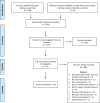Evaluating the impact of virtual reality game training on upper limb motor performance in children and adolescents with developmental coordination disorder: a scoping review using the ICF framework
- PMID: 38840217
- PMCID: PMC11151681
- DOI: 10.1186/s12984-024-01393-y
Evaluating the impact of virtual reality game training on upper limb motor performance in children and adolescents with developmental coordination disorder: a scoping review using the ICF framework
Abstract
Objective: This scoping review aims to explore published literature testing Virtual Reality (VR) interventions for improving upper limb motor performance in children and adolescents with Developmental Coordination Disorder (DCD). Our primary focus was on the types of VR systems used and the measurement tools employed within the International Classification of Functioning, Disability and Health Children and Youth Version (ICF-CY) domains in these studies.
Methods: A comprehensive search of six electronic databases up to 11th January 2024 was conducted using predefined terms. Inclusion and exclusion criteria were applied to determine study eligibility, with two authors independently assessing titles, abstracts, and full-text articles.
Results: Out of 788 potential studies, 14 met the eligibility criteria. Studies predominantly utilized non-immersive VR (nVR) systems, for example, commercial platforms such as Nintendo Wii. Most interventions targeted general motor coordination or balance, with only four studies specifically focusing on upper limb motor performance. The Movement Assessment Battery for Children-2 was the predominant assessment tool. However, the use of game scores and trial durations raised concerns about the accuracy of assessments. The majority of studies reported no significant improvement in upper limb motor performance following VR interventions, though some noted improvements in specific tasks or overall outcomes.
Conclusion: The findings suggest that, while nVR interventions are being explored for paediatric motor rehabilitation, their impact on enhancing upper limb motor performance in children with DCD is unclear. The variability in intervention designs, outcome measures, and the predominant focus on general motor skills rather than specific upper limb improvements highlight the need for more targeted research in this area.
Impact: This review underscores the importance of developing precise and clinically relevant measurement tools in a broader range of VR technologies to optimize the use of VR in therapy for children with DCD. Future research should aim for more rigorous study designs and emerging immersive technologies to maximize therapeutic benefits.
Keywords: DCD; Dyspraxia; Paediatric; VR.
© 2024. The Author(s).
Conflict of interest statement
The authors declare that they have no known competing financial interests or personal relationships that could have appeared to influence the work reported in this paper.
Figures
Similar articles
-
Do video game interventions improve motor outcomes in children with developmental coordination disorder? A systematic review using the ICF framework.BMC Pediatr. 2019 Jan 16;19(1):22. doi: 10.1186/s12887-018-1381-7. BMC Pediatr. 2019. PMID: 30651097 Free PMC article.
-
Is virtual reality effective in improving the motor performance of children with developmental coordination disorder? A systematic review.Eur J Phys Rehabil Med. 2019 Apr;55(2):291-300. doi: 10.23736/S1973-9087.18.05427-8. Epub 2018 Oct 4. Eur J Phys Rehabil Med. 2019. PMID: 30311491
-
The efficacy of virtual reality interventions compared with conventional physiotherapy in improving the upper limb motor function of children with cerebral palsy: a systematic review of randomised controlled trials.Disabil Rehabil. 2023 Jun;45(11):1773-1783. doi: 10.1080/09638288.2022.2071484. Epub 2022 May 16. Disabil Rehabil. 2023. PMID: 35575755
-
Motor intervention with and without Nintendo® Wii for children with developmental coordination disorder: protocol for a randomized clinical trial.Trials. 2019 Dec 30;20(1):794. doi: 10.1186/s13063-019-3930-2. Trials. 2019. PMID: 31888736 Free PMC article.
-
Relationship between perceived competence and performance during real and virtual motor tasks by children with developmental coordination disorder.Disabil Rehabil Assist Technol. 2017 Oct;12(7):752-757. doi: 10.1080/17483107.2016.1261305. Epub 2017 Jan 18. Disabil Rehabil Assist Technol. 2017. PMID: 28098503
Cited by
-
Effects of virtual reality motor games on motor skills in children with cerebral palsy: a systematic review and meta-analysis.Front Psychol. 2025 Jan 6;15:1483370. doi: 10.3389/fpsyg.2024.1483370. eCollection 2024. Front Psychol. 2025. PMID: 39881687 Free PMC article.
References
Publication types
MeSH terms
LinkOut - more resources
Full Text Sources
Miscellaneous


